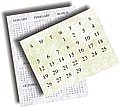
 | home projects suggestions |
| philosophy newsletter faq |
 |
Perpetual Calendar |
| Basic Description |
This is an amazing calendar that remains functional for thousands of years. We have three versions: the first is an online version intended for online viewing and printing of selected pages. The year-at-a-glance version uses fourteen ordinary sheets of paper and extends from the year 1600 to 10000. Our favorite is the monthly version that spans 2800 years and fits on 28 sheets of paper. If you used traditional wall calendars during that period, you would need at least 30,000 sheets of paper! Don't worry these aren't microscopic: the pages are full-size. |
| Materials | Paper |
| Tools | Acrobat Reader, computer printer |
| Cost | The plan itself is free! Estimated materials cost: $1 - $2 |
| Time | Fifteen minutes to make but it lasts virtually forever (if the paper makes it that long). |
| Difficulty | Easy |
| Similar Projects | 'complico' paper folding puzzle, million wall |
| Related Projects | wall holder for the perpetual calendar |
We suggest that you make a few simple customizations to get the most out of this project. The design of this site is not flashy and that is intended.
First you need to decide which calendar you want to make. If you simply want to view a particular month in the past (as early as 1600) or the future (up to the year 10000), you can visit the online perpetual calendar. You can view or print individual months or years during this 8400 year span. This is perfect for looking at the day of the week you were born or planning for the distant future. |
monthly view: |
 |
|
If you would like a printed version of a perpetual calendar then you can choose between the monthly or yearly view, or you can opt for both! The monthly view requries 28 sheets of paper to be printed on both sides. See the image at the right for a sample page. The yearly-view requires 14 printed sheets: it has the twelve months of a given year on individual pages. See the sample to the right. You can click on the samples to see sample versions. |
yearly view: |
 |

Now you need to test the printing of the calendar of your choice. We are providing this test to ensure that the acrobat files are printing properly on your system and to show you how to orient the papes properly in your printer.
To do this, you will need the Acrobat Reader installed on your computer. If you do not have the reader, please click on the link and follow the instructions to install it.
We offer each calendar in two paper sizes (letter and A4). Each paper size has two files, one for the fronts of the page and one for the backs. After printing one side of the paper, you will need to place the paper the opposite way into your printer, but make sure that top of the printed side is closer to the printer.

Letter paper:
A4 paper:

If you are having any problems with the download or printout, you should visit the acrobat troubleshooter page. Make sure that you didn't print the two files on the same side of the paper. If so, you need to flip the sheet over before printing the back side. Now, look at both sides of the sheet: the orientation arrows should be pointing in the same direction. Also check the quality of the print. The numbers should be crisp and the background should be white. If the orientation matches and the print looks good, make a mental note of how you oriented the paper into the printer and you're ready to move on.
Now lets print. Again, each calendar has two files: one for the fronts and one for the backs. After printing the fronts of the set, then you take the stack and print out the back sides--orienting the stack in the same way that you did during the test. Note that the monthly view requires 28 sheets of paper, and the yearly view requires 14 sheets.
A note about materials. You are about to print a calendar that will be functional for thousands of years. The pages will be handled frequently so we recommend that you opt for the best quality and durable paper that you can find. Heavy acid-free or archival-quality paper is probably the best bet, but of course any paper you choose will work. Laser and ink-jet printers have not been around long enough to determine the longevity of prints. While the ink may fade after a significant number of years, we reckon that the calendars will be readable for a sufficient period of time.
Letter paper:
A4 paper:
Next, you need to learn how to use the calendars.

Lots of text and pictures will be placed in this step. i just havent had time to complete it yet. im writing a bunch of text right now, to simulate what it may look like when i actually port the text into this area. Lots of text and pictures will be placed in this step. i just havent had time to complete it yet. im writing a bunch of text right now, to simulate what it may look like when i actually port the text into this area. Lots of text and pictures will be placed in this step. i just havent had time to complete it yet. im writing a bunch of text right now, to simulate what it may look like when i actually port the text into this area.
Yet even more text, descriptions and anecdotes will go here. again i am just filling the text area to simulate what the finished product may look like when the actual text gets input. Yet even more text, descriptions and anecdotes will go here. again i am just filling the text area to simulate what the finished product may look like when the actual text gets input. Yet even more text, descriptions and anecdotes will go here. again i am just filling the text area to simulate what the finished product may look like when the actual text gets input. Yet even more text, descriptions and anecdotes will go here. again i am just filling the text area to simulate what the finished product may look like when the actual text gets input. Yet even more text, descriptions and anecdotes will go here. again i am just filling the text area to simulate what the finished product may look like when the actual text gets input. Yet even more text, descriptions and anecdotes will go here. again i am just filling the text area to simulate what the finished product may look like when the actual text gets input.
Background information: The idea for a perpetual calendar first occured to me when I realized that there are only a limited number of potential layouts for a calendar month. It turns out that we at UNIQUEPROJECTS did not invent the perpetual calendar, but the process of figuring it all out was enjoyable nonetheless.
A month can either have 28, 29, 30, or 31 days. (Februaries always have 28 days unless its a leap year in which case they have 29). Furthermore, each month can only start on one of seven days, Monday through Sunday. This makes a total of 28 possible monthly layouts because four (total number of possible days in a month) times seven (days on which any given month can start) equals 28. The only missing element at this point is which layout is linked to which month. We accomplished this with some tricky formulas in spreadsheet software.

Annual calendars are slightly different. January always has 31 days but it can start on any of seven days of the week, depending on the year in question. That means that the day of the week of February first is dependent on the day of the week of the January first. For example, if January starts on a Sunday, February must start on a Wednesday. February, however, can either be 28 days or 29 days depending on whether the year in question is a leap year; see the calendar to the right. The remaining months of the year have fixed amounts of days. (Click on the image of the two fists below for a unique way to determine how many days there are in a given month). Therefore, January can start on any of seven days when it is a non-leap year and it can start on any of seven days when it is a leap year: this creates 14 yearly possibilities. With this established, the only requirement is to determine which years were leap years and on which day January started for a given year.
The rules of the calendar are rather interesting. Of course, a year is not an arbitrary period of time, it is an astronomic reality. A year represents the time it takes for the earth to orbit around the sun. A good calendar therefore, needs to match this period of time. It takes 365.242 days for the earth to complete the trip. Instead of adding .242 of a day (5 hours 48 minutes and 30 seconds) to a 365-day year the leap year system was devised. Every four years an extra day was added to the 365 days in the regular calendar. This system is relatively accurate, but .242 is not exactly the .250 of a day that it needs to be for the leap day to work perfectly. Over the centuries the .008 (.250 minus .242) of a day or 11 minutes 30 seconds began to add up. The continuing accumulation came to an end in 1582 when Pope Gregory XIII stated that 10 days in October were to be removed from the calendar that year. This made for a bizarre October 1582. You can imagine what people's datebooks looked like that month.
Pope Gregory XIII, for whom the modern calendar is named after, also established a system to prevent the accumulation from beginning all over again. Every four years divisible by four would continue to be a leap year, but years divisible by 100 would not unless they are also divisible by 400. So the year 2000 was one of these special years that comes once every four centuries: divisible by 100 but also divisible by 400--a non-leap year. This new system is far superior to the outdated one it replaced, but its still not 100% perfect. When you do the math, there still is a miniscule accumulation and perhaps in thousands of years another day will have to be stricken from the calendar or perhaps a leap year bypassed.
An option at this point is to make a wall holder for your new calendar.
If you enjoyed this, you may want to sign up for our free newsletter for weekly updates including new project notification. You can also email a friend about this project or website.